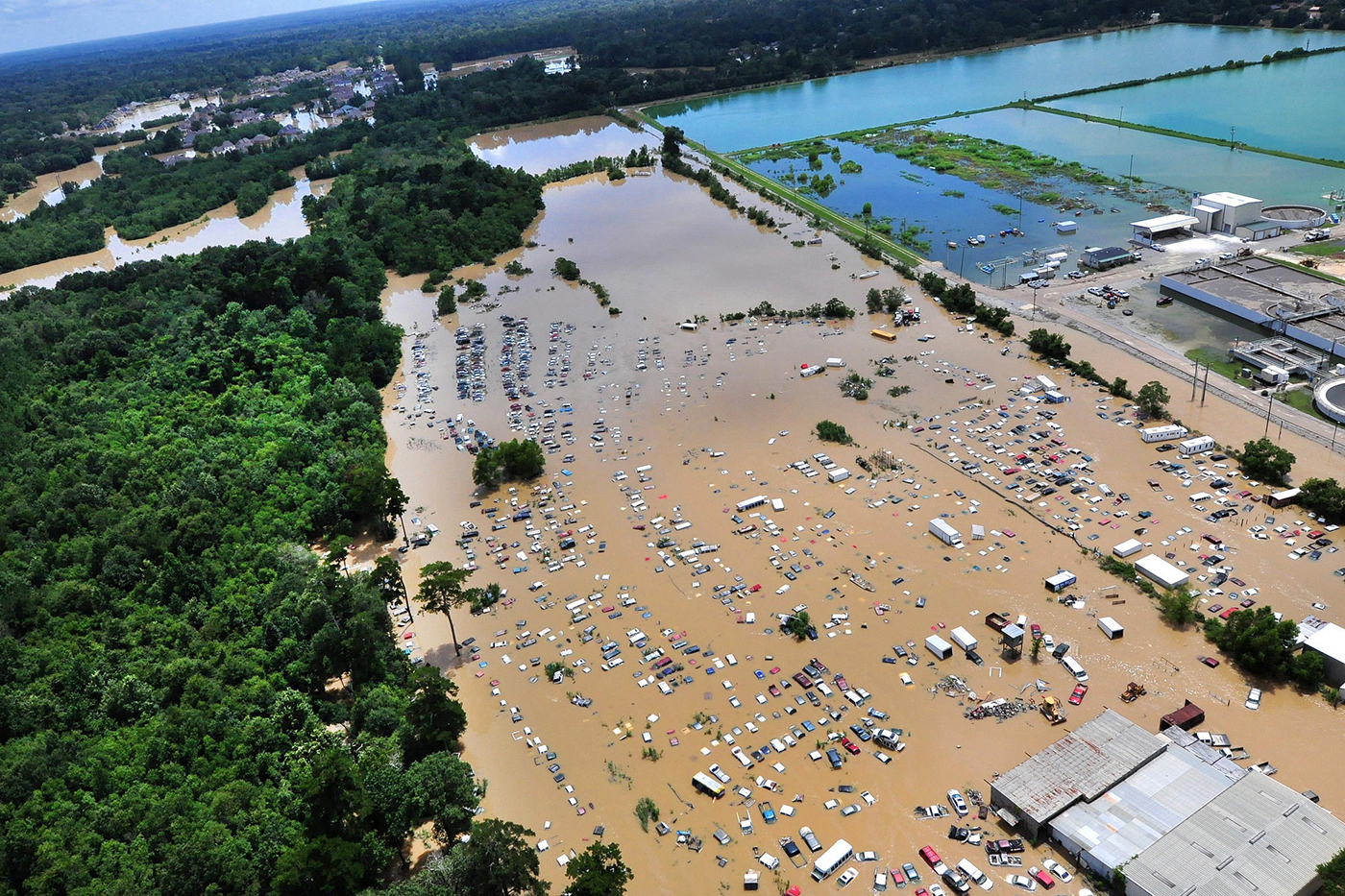
Climate change doubled the chances of Louisiana heavy rains, scientists warn
Roz Pidcock
09.07.16Roz Pidcock
07.09.2016 | 4:00pmTorrential rains unleashed on south Louisiana in August were made almost twice as likely by human-caused climate change, according to a quick-fire analysis released just weeks after the flood waters subsided.
The team of scientists concluded that such an event is expected to occur a minimum of 40% more often now than in 1900, but their best estimate is that the odds have now halved.
Dr Friederike Otto, a senior researcher in extreme weather and attribution in the Environmental Change Institute at Oxford University, who wasn’t involved in the research, tells Carbon Brief:
The new research is the latest in what are known as “single event attribution” studies. This one is notable for being the first collaboration between scientists at the World Weather Attribution (WWA) project and the US National Oceanic and Atmospheric Administration (NOAA).

A view from an MH-65 Dolphin helicopter shows flooding and devastation in Baton Rouge, Louisiana, 15 August 2016. Credit: Melissa Leake/US Department of Agriculture.
Historic rains
On 10 Aug 2016, a low pressure system swept into south Louisiana from the Gulf of Mexico. A combination of unusually warm water providing extra “fuel” for the storm and its sluggish movement meant it dumped a huge amount of rain in one area for several days in a row.
The WWA team said in a summary accompanying their findings:
The Baton Rouge area saw record breaking rainfall, receiving nearly 30cm in a single day on 12 Aug. Other parts of the state saw more than 75cm over the course of a week. WWA explains:
The rains and subsequent flooding in and around Louisiana claimed 13 lives and damaged more than 60,000 homes, leading the Red Cross to declare it the worst natural disaster in the United States since Superstorm Sandy hit the east coast in 2012.

Total three-day precipitation for August 12-14, 2016. Source: Climate Central
Human role
As has become customary when events like these occur, many speculated about how human activity had altered the nature of the flooding and, therefore, how much had been avoidable.
The impacts of a warming climate on heavy rain are well understood. Basic physics dictates an increase in the amount of atmospheric moisture, which means we can expect prolonged rainfall events to be more intense under climate change, raising the risk of flooding.
The team behind today’s study set to work using two of NOAA’s high-resolution climate models to examine how the odds of Louisiana experiencing a storm of this size have changed between the mid 19th century, before the influence of human activity took hold, and today.
Their analysis took account of how changes in greenhouse gases, aerosols (such as soot and dust), ozone, volcanic eruptions and natural fluctuations in the sun’s activity have altered the chances of an event of this magnitude occurring.
The scientists also looked at measurements from 324 weather stations and compared how often the conditions experienced at the height of the Louisiana storm featured in the historical record.
They concluded that the three-day rainfall Louisiana experienced between 12-14 August is far more likely than before the world started industrialising. Dr Karin van der Wiel, a research associate at NOAA’s Geophysical Fluid Dynamics Laboratory (GFDL) and the lead author on the new study, says:
The WWA scientists’ summary says:
Complex picture
The study uses an identical approach to other attribution studies, such as a recent one that looked at the role of human activity in flooding across France and Germany in May 2016.
But the Louisiana rainfall was a particularly complicated case, say the scientists, because they had to take into account all the ways that extreme rainfall can occur, including hurricanes, frontal systems, and thunderstorms.
Dr Geert Jan van Oldenborgh of the Royal Netherlands Meteorological Institute, part of the research team, said:
Dr Heidi Cullen, chief scientist at Climate Central, the organisation that leads WWA, echoes this point, explaining why this means the team have high confidence in their results. She tells Carbon Brief:
The team has submitted their results to the journal Hydrology and Earth System Sciences, which means they are still subject to peer-review. But the methods underlying the findings are well established, the scientists explain.
Dr Peter Stott, head of climate monitoring and attribution at the Met Office, is more cautious. He tells Carbon Brief:
Stott suggests while the information is undoubtedly useful for insurers, policy makers, engineers and emergency managers, some users might prefer a slower delivery if it means more chance to fully assess its reliability. He adds:
Already pushing the traditional boundaries of science and aligning more with news cycles, attribution methods are advancing all the time. Soon, scientists might be able to analyse more complex weather events in the same way, says Otto. She tells Carbon Brief:
Given the destruction such events cause and the huge media attention they get, providing scientific evidence instead of just opinions when questions about humans’ role are being asked will be critical, says Otto. Oldenborgh agrees, telling Carbon Brief:
Understanding all the ways we humans are altering the weather is important, but there’s an even more immediate motivation on the ground. Louisiana is an area already at risk of flooding and we will only see more extreme rainfall events as greenhouse gas emissions climb higher, Cullen reflects. She tells Carbon Brief:

